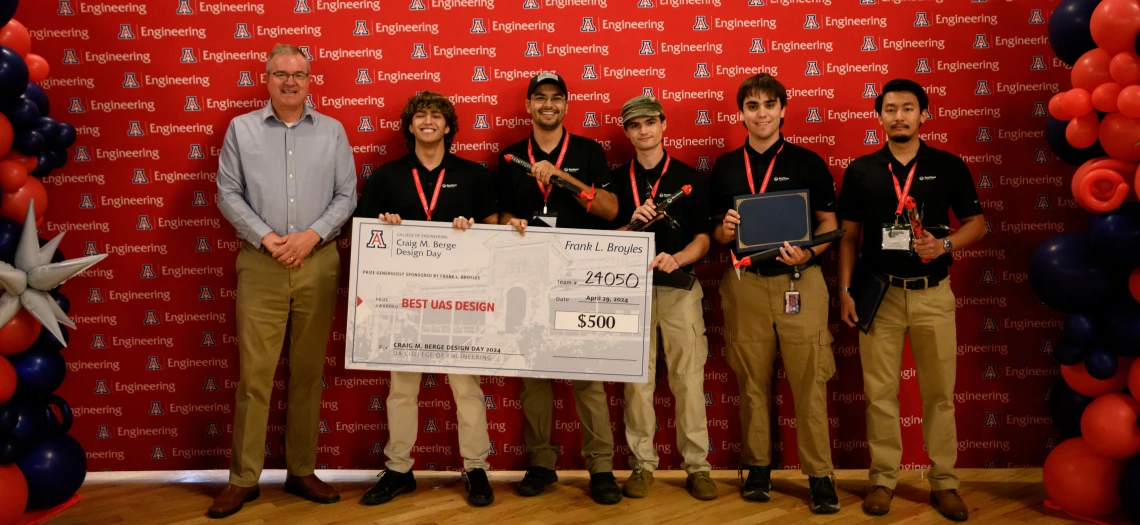Team earns a win, presents drone to government agency consortium
The rocket-shaped drone could help first responders, law enforcement and search and rescue workers perform more effectively.

Craig M. Berge Dean David W. Hahn presents the Frank L. Broyles Award for Best UAS Design to 24050 team members (from left) Maximo X. Ybarra, Chuy Talavera, Nathan Randall Julicher, Thomas Schwab and Jason Li.
Engineers love facing a raft of challenging parameters and coming up with a design or product that threads the needle on all of them.
Create a drone that is economical, reliable, deploys to its working altitude quickly and quietly, and that can be made with readily available components? No problem for Team 24050, which built a novel rocket-shaped drone that ticked all the boxes. In the process, the team won the $500 Frank L. Broyles Award for Best UAS Design at this year’s Craig M. Berge Design Day, held in April.
“It was a hands-down win,” said award sponsor Frank Broyles. “Their project is just truly an outstanding, well-thought-out, practical application.”
Broyles, who graduated with a mining engineering BS in 1968, became an attorney and practices in the Dallas area. But he’s never left engineering behind, and he has been judging University of Arizona capstone projects for years.
Smart design, deep knowledge
Project sponsor Raytheon Technologies tasked Team 24050 with completing a drone project that began in the 2022 capstone year. But, in practical terms, the drone needed almost a full reset.
“We completely redesigned the airframe. We used a different camera system. So we took a lot of the lessons learned from phase one and used them to iterate for a completely new design,” said team lead Nathan Randall Julicher, who graduates this summer with a mechanical engineering degree.
The team’s drone looks more like a model rocket than a typical quad copter, and that’s because it is launched from a pneumatic tube. Once it reaches the desired altitude – up to around 300 feet – the drone pilot remotely jettisons the rear assembly on the craft to deploy four propellers on forearms, which snap out of the fuselage of the drone by means of an elastic shock cord. The pneumatic launcher gets the drone aloft in a hurry and also saves precious battery power.
The drone is designed for use by first responders, search and rescue, or law enforcement workers. Under certain circumstances it may not be retrievable, so the design had to be low-cost.
“Disposable is a relative term, of course,” said Julicher. “For a government agency or police force, that might mean a few hundred dollars.”
Julicher is an avid aviator. He has a private pilot’s license and acquired a Part 107 drone pilot’s license specifically for the capstone project. While that didn’t turn out to be necessary for the project, Julicher said, he wanted to be extra careful.
Broyles was impressed. “For a student engineer to hold a Part 107 license, I loved it from the get-go,” he said. “It's the first time I've ever run into that.”
Educating potential users
Given the potential first responder applications of Team 24050’s drone, Broyles asked Julicher to give a presentation to the North Central Texas Council of Governments, a consortium of Texas counties.
“I became pretty fascinated with what was going on legally in the drone world," Broyles said. "The counties want to make sure that a drone could fly from one county into another without having to encounter changes in local drone regulations."
Broyles, who has been working with the NCTCOG for more than five years, explained that the group also wanted to learn more about how drones operate for economic reasons.
"They consider drones and drone enterprises a potential major economic driver, so I recommended that they hear from Nathan."
The two-hour session took place in early May. In addition to Julicher, representatives from several drone companies – some international – presented on their products via Zoom. Broyles reported: "I thought Nathan's was by far the best of the group.”

